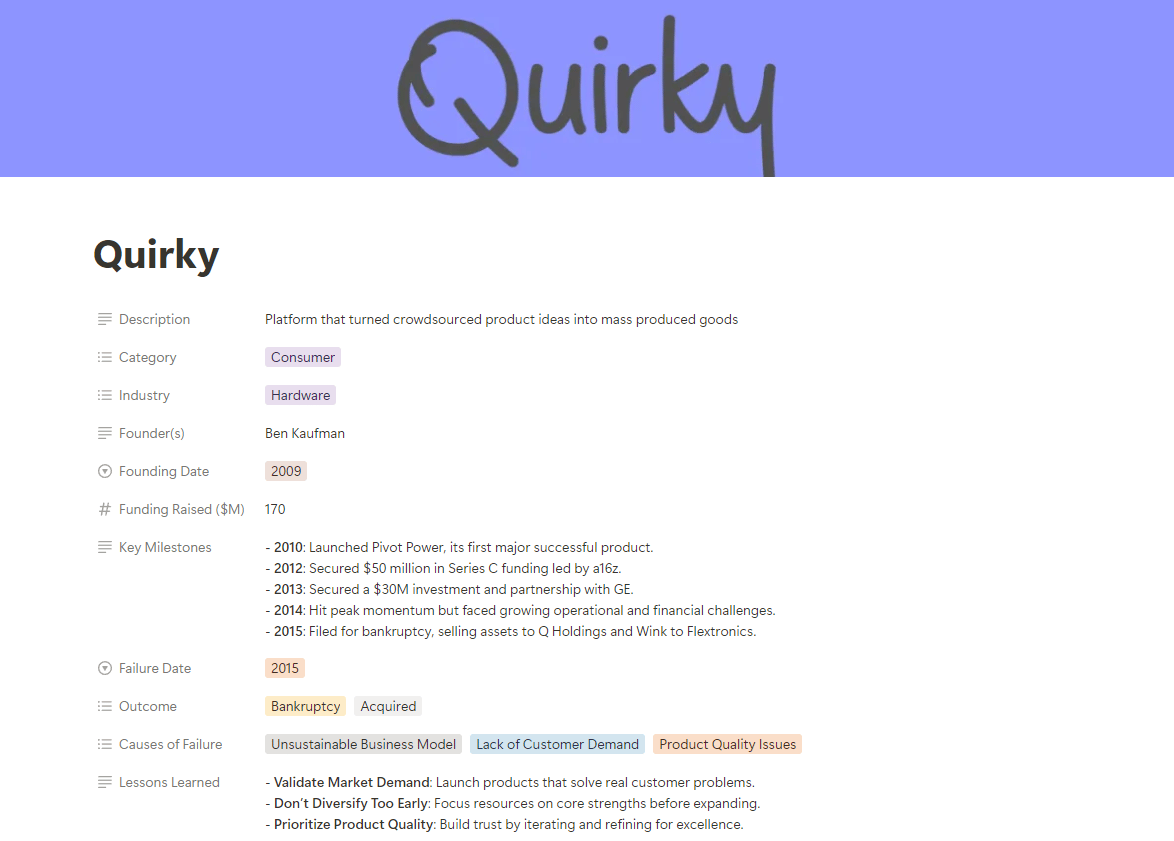- The Startup Graveyard
- Posts
- Quirky: The Invention Factory That Burned Through $200M
Quirky: The Invention Factory That Burned Through $200M
From 50 Product Launches a Year to Bankruptcy

Quirky Overview

The Rise & Fall of Quirky
Quirky started in 2009 with a bold vision from 22-year-old Ben Kaufman create a platform where anyone could pitch invention ideas, the community would vote on them, and Quirky would take care of the rest—design, production, and marketing. Successful inventors would earn royalties, making innovation feel accessible and collaborative.
The Rise
It didn’t take long for Quirky to catch attention. Its first hit came in 2010 with the Pivot Power, a flexible power strip that became a massive success. This gave the company momentum to raise $6 million in funding and grow its operations.
By 2012, the platform had more than 200,000 users, and raised $50 million with a16z to support its ambitious goal of launching 50+ products a year. Big partnerships with GE, Bed Bath & Beyond, Amazon, and Target also came in to provide the distribution and credibility needed to scale.
By 2013, Quirky had over half a million community members, thousands of weekly submissions, and two more major hits: the Aros Air Conditioner and the Flexi Tray. Its growing fanbase and rapid product launches cemented its reputation as an innovative startup.
The Fall
As Quirky scaled, the cracks started to show. Hardware is expensive, and Quirky handled everything—from design to manufacturing and even inventory—resulting in massive overhead costs. Its move fast mentality led to rushed, poorly tested products. While a handful of ideas thrived, most of the 400+ products launched failed to take off.
In 2014, Quirky tried to shift gears, repositioning itself as a crowdsourcing partner for big brands like Mattel and Amazon to reduce inventory risk. But the pivot flopped—these large retailers already had their own pipelines for innovation.
By 2015, Quirky was burning through cash. CEO Ben Kaufman stepped down, and the company filed for bankruptcy. Its smart home division, Wink, sold for $15 million, while its remaining assets went to Q Holdings for just $5 million.
In 2016, a relaunch under new leadership aimed to simplify the model by licensing ideas to partners like HSN and Shopify. However, Quirky never regained its former momentum and quietly disappeared.
What Went Wrong?
Unsustainable Business Model
Quirky’s target of launching 50 products a year created immense financial and operational strain. Taking full responsibility for manufacturing, marketing, and distribution split resources and racked up costs. Unlike Kickstarter, which shifts risks to creators, Quirky took on everything, making the model too expensive to scale profitably.
Lack of Consumer Demand
Many of Quirky’s community-chosen products didn’t address real consumer needs. Without proper market validation, millions were wasted on R&D for ideas that failed to sell, like the Egg Minder, a smart tray that tracked egg freshness. Moreover, the lack of focus across its product line hurt brand identity and limited repeat purchases.
Product Quality Issues
In its rush to launch new products, Quirky often sacrificed quality. Frequent delays, design flaws, and inconsistent execution damaged its reputation. Additionally, the over-diversification of its lineup—from kitchen gadgets to smart home devices—made maintaining high standards nearly impossible, leading to returns, unsold stock, and financial losses.
Key Lessons
1. Validate Market Demand
Quirky wasted resources on products nobody wanted. Test market interest before investing in development.
2. Don’t Diversify Too Early
Quirky tried to do too much too soon. Start with one niche and build strength before expanding.
3. Product Quality Matters
Rushed, low-quality products hurt Quirky’s reputation. A great product is the foundation of business success.
Thanks for reading the third article of The Startup Graveyard. If you're curious to dig deeper into Quirky, check out these resources: NY Mag, Harvard, Beneinstein.
Make sure to follow @startupgravyd on socials for bite-sized content.